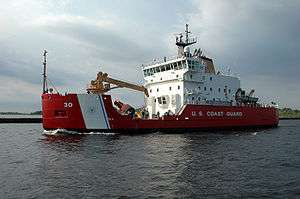USCGC Mackinaw (WLBB-30)
USCGC Mackinaw (WLBB-30) is a 240-foot (73 m) vessel built as a heavy icebreaker for operations on the North American Great Lakes for the United States Coast Guard.[3] IMO number: 9271054. She should not be confused with a namesake ship, the USCGC Mackinaw (WAGB-83), IMO number 6119534, which was decommissioned on June 10, 2006.
 | |
| History | |
|---|---|
| Builder: | Marinette Marine Corporation (MMC) |
| Laid down: | February 09, 2004 |
| Launched: | April 2, 2005 |
| Commissioned: | June 10, 2006 |
| Homeport: | Cheboygan, Michigan[1] |
| Identification: |
|
| General characteristics | |
| Displacement: | 3,500 tons |
| Length: | 240 ft (73 m) |
| Beam: | 58.5 ft (17.8 m) |
| Draft: | 16 ft (4.9 m) |
| Propulsion: |
|
| Speed: | 16 knots (30 km/h) |
| Complement: | 9 Officers, 46 Enlisted |
| Armament: |
|
| Capacity: |
|
Background
Mackinaw was delivered to the Coast Guard on November 18, 2005 and commissioned on June 10, 2006. In addition to her ice-breaking duties, the Mackinaw will also serve as an Aids to Navigation ship, able to perform the same duties as the Seagoing Buoy Tenders (WLB) of the Coast Guard fleet. Further, she can conduct law enforcement and search and rescue missions and can deploy an oil skimming system to respond to oil spill situations and environmental response.[3]
Mechanical specifications
.jpg)
One of the Mackinaw's unique features in the US Coast Guard fleet is the use of two Azipod units, ABB's brand of electric azimuth thrusters, for her main propulsion. These, coupled with a 550 hp (410 kW) bow thruster, make the ship exceptionally maneuverable. The Azipod units also remove the need for a traditional rudder, as the thrusters can turn 360 degrees around their vertical axis to direct their thrust in any direction. The Mackinaw also lacks a traditional ship's steering wheel. Much of the ship’s technology, including the Azipod thrusters, is from Finnish Maritime Cluster.[3] Additionally, the Mackinaw can continuously proceed through fresh water ice up to 32 inches (81 cm) thick at 3 knots or 14 inches (36 cm) at 10 knots. She can also break smooth, continuous ice up to 42 inches (107 cm) thick through ramming.
History
The Mackinaw got off to a rocky start before being commissioned. While en route to her new home port of Cheboygan, Michigan, the Mackinaw struck a seawall in Grand Haven, Michigan on December 12, 2005. The accident caused a 10-foot (3.0 m) dent in the bow of the Mackinaw on her starboard side. Shortly after the accident, Captain Donald Triner, the commanding officer of the Mackinaw, was temporarily relieved of duty pending an investigation into the accident. The accident did not delay the ship's scheduled arrival in her new home port; she arrived on December 17, 2005. Captain Triner was later permanently relieved of duty[4] and replaced by Captain Michael Hudson, who was replaced in turn by Commander John Little in April 2006. CDR Scott J. Smith assumed command in July 2008 and was relieved by CDR Michael J. Davanzo in Aug, 2011. In June 2014, CDR Vasilios Tasikas assumed command. In June 2017, CDR John Stone assumed command.
The Mackinaw is stationed at Cheboygan, Michigan.[1] It can be seen and toured at Grand Haven's Coast Guard Festival every summer. The ship was also featured on the television series Modern Marvels.
Katmai Bay, stationed at Sault Ste. Marie, Michigan,[5] helps the USCGC Mackinaw (WLBB-30) in ice breaking duties.[6][7][8][9][10][11]
Gallery
 USCGC Mackinaw on launch day, April 2, 2005.
USCGC Mackinaw on launch day, April 2, 2005. Breaking the champagne bottle on the bow of USCGC Mackinaw on launch day, April 2, 2005.
Breaking the champagne bottle on the bow of USCGC Mackinaw on launch day, April 2, 2005. Closeup of one of the ship's Azipods.
Closeup of one of the ship's Azipods. USCGC Mackinaw sliding towards the river during the launch.
USCGC Mackinaw sliding towards the river during the launch. USCGC Mackinaw impacting the river.
USCGC Mackinaw impacting the river..jpg) The Mackinaw's Engineering Control Center, where the engineering watchstanders monitor the ship's machinery
The Mackinaw's Engineering Control Center, where the engineering watchstanders monitor the ship's machinery Mackinaw assisting a freighter in ice
Mackinaw assisting a freighter in ice
References
- "USCGC Mackinaw (WLBB-30)". United States Coast Guard. Retrieved May 1, 2017.
- "USCGC MACKINAW (WLBB-30) Characteristics". www.atlanticarea.uscg.mil. United States Coast Guard. Retrieved 3 June 2019.
- "Great Lakes Icebreaking (GLIB) Capability Replacement Project Fact Sheet" (PDF). February 2008. Retrieved February 14, 2016.
- Quackenbush, Jeff; Michael Hoffman (12 Jan 2006). "Mackinaw Captain Removed From Duty". WZZM. Gannett Broadcasting. Retrieved 2012-06-25.
- "USCGC Katmmai Bay (WTGB 101)". United States Coast Guard. 26 January 2012.
- King, Dominique (April 15, 2014). "From Monroe to Mackinac: Lighthouse moves to Chief Wawatam Park in St. Ignace,". Michigan Midwest Guest. Retrieved April 25, 2017.
- "U.S. Coast Guard Sector Sault Sainte Marie". U.S. Coast Guard Sector. Retrieved April 30, 2017.
- Heffernan, Tim (February 25, 2016). "Ice Breakers: The Coast Guard Crews That Keep the Great Lakes Open for Business". Popular Mechanics. Retrieved April 30, 2017.
- Ellison, Garret (January 8, 2015). "The freeze is on: Coast Guard begins ice-breaking on western Great Lakes". Mlive. Retrieved April 30, 2017.
- Final survey, Great Lakes-St.Lawrence Seaway Navigation Extension: Environmental Impact Statement. 5. Detroit, Michigan: U.S. Army Corps of Engineers. August 1979. p. 95. Retrieved April 30, 2017.
- "USCG Cutter Mackinaw Icebreaker Moored in Sault Ste. Marie, Michigan" (Video). March 20, 2014. Retrieved April 30, 2017 – via YouTube.
External links
| Wikimedia Commons has media related to USCGC Mackinaw (WLBB-30). |
- Chicago's Christmas Ship, The Mackinaw delivers Christmas trees annually to Chicago
- The official Mackinaw website.
- Many photos, including the "splash" launch of the Mackinaw.